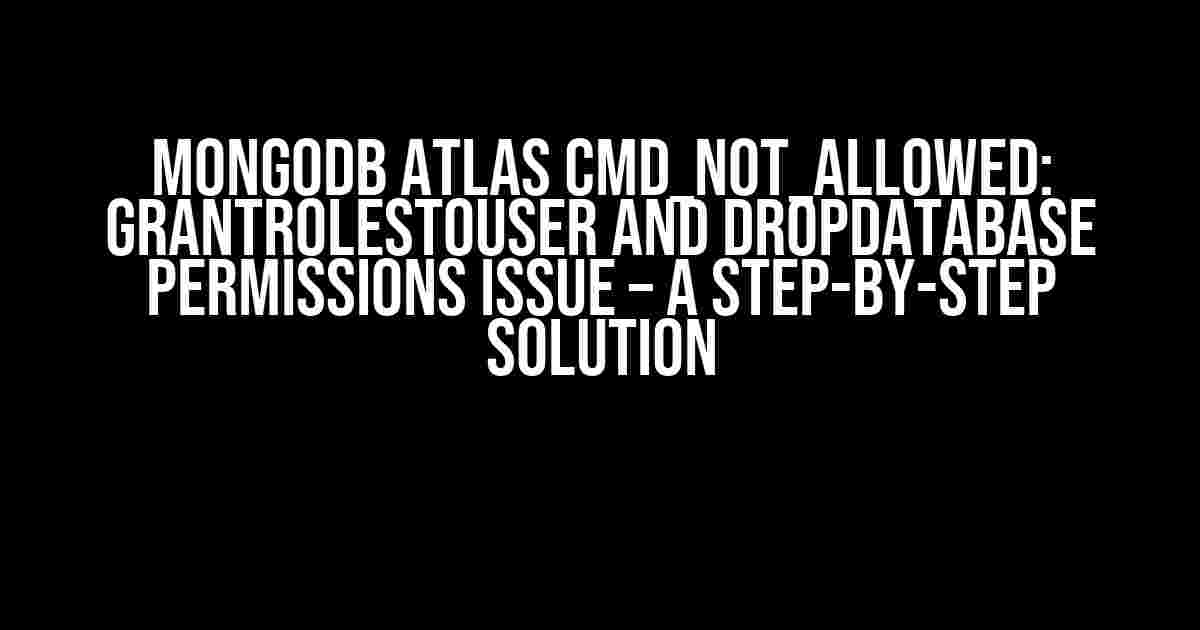Are you tired of encountering the frustrating CMD_NOT_ALLOWED error when trying to grant roles to a user or drop a database in MongoDB Atlas? You’re not alone! This issue has been plaguing developers and admins alike, causing headaches and wasting precious time. Fear not, dear reader, for we’ve got a comprehensive solution to this pesky problem.
What is the CMD_NOT_ALLOWED Error?
The CMD_NOT_ALLOWED error occurs when your MongoDB Atlas user lacks the necessary permissions to execute certain commands, such as grantRolesToUser or dropDatabase. This error is often encountered when working with MongoDB Atlas clusters, particularly when trying to manage user roles or perform database operations.
Why Does This Error Happen?
The primary reason for this error is the lack of proper permissions assigned to the MongoDB Atlas user. By default, MongoDB Atlas creates a user with limited permissions, which can lead to the CMD_NOT_ALLOWED error when trying to execute commands that require elevated privileges.
Solution: Granting Necessary Permissions to Avoid CMD_NOT_ALLOWED Error
To resolve the CMD_NOT_ALLOWED error, we’ll need to assign the necessary permissions to the MongoDB Atlas user. Follow these step-by-step instructions to grant the required permissions:
Step 1: Create a New Custom Role
First, we’ll create a custom role that includes the necessary permissions. Log in to your MongoDB Atlas cluster and navigate to the Security tab.
In the Roles section, click the New Custom Role button.
Role Name: atlasAdmin Description: Custom role for MongoDB Atlas admin tasks
Step 2: Add Permissions to the Custom Role
In the Privileges section, add the following permissions:
- grantRole: true
- dropDatabase: true
- createRole: true
- updateRole: true
- dropRole: true
These permissions will allow the user to grant roles to other users, drop databases, and manage custom roles.
Step 3: Assign the Custom Role to the MongoDB Atlas User
Navigate to the Users section and select the user that requires the elevated permissions.
Click the Edit button next to the user’s role.
Role: atlasAdmin
Assign the custom role (atlasAdmin) to the user.
Verifying the Solution
After assigning the custom role to the user, verify that the CMD_NOT_ALLOWED error has been resolved.
Testing grantRolesToUser Command
mongo "mongodb+srv://cluster0-shard-0/replicaSet"
use admin
db.runCommand({ grantRolesToUser: "newUser", roles: [{ role: "readWrite", db: "mydatabase" }] })
The command should execute successfully, granting the readWrite role to the newUser on the mydatabase database.
Testing dropDatabase Command
mongo "mongodb+srv://cluster0-shard-0/replicaSet"
use admin
db.runCommand({ dropDatabase: 1, name: "mydatabase" })
The command should execute successfully, dropping the mydatabase database.
Best Practices for MongoDB Atlas Security
To ensure the security of your MongoDB Atlas cluster, follow these best practices:
- Least Privilege Principle: Assign only the necessary permissions to users and roles.
- Role-Based Access Control (RBAC): Use custom roles to manage permissions and access to resources.
- Regularly Review and Update Permissions: Periodically review and update permissions to ensure they align with changing requirements.
- Monitor and Audit Cluster Activity: Regularly monitor and audit cluster activity to detect and respond to potential security incidents.
Conclusion
The CMD_NOT_ALLOWED error in MongoDB Atlas can be a frustrating obstacle, but by following the step-by-step instructions in this article, you should be able to grant the necessary permissions to your user and resolve the issue. Remember to follow best practices for MongoDB Atlas security to ensure the integrity and protection of your data.
| Permission | Description |
|---|---|
| grantRole | Grants a role to a user |
| dropDatabase | Drops a database |
| createRole | Creates a custom role |
| updateRole | Updates a custom role |
| dropRole | Drops a custom role |
By now, you should have a clear understanding of how to resolve the CMD_NOT_ALLOWED error in MongoDB Atlas. If you have any further questions or concerns, please feel free to ask in the comments section below.
Frequently Asked Question
MongoDB Atlas can be a bit tricky when it comes to permissions, but don’t worry, we’ve got you covered! Check out these frequently asked questions and answers to help you navigate the world of grantRolesToUser and dropDatabase permissions.
What is the CMD_NOT_ALLOWED error in MongoDB Atlas?
The CMD_NOT_ALLOWED error occurs when a user tries to execute a command that requires permissions they don’t have. In the case of grantRolesToUser and dropDatabase, the user must have the necessary roles and privileges to perform these actions. Make sure to check the user’s roles and permissions before attempting to execute these commands!
Why do I get a CMD_NOT_ALLOWED error when trying to grant roles to a user in MongoDB Atlas?
This error typically occurs when the user executing the grantRolesToUser command doesn’t have the necessary permissions to modify roles. To fix this, ensure that the user has the grantRole or restoreAdminRoles permission on the admin database. You can also check if the user is part of a role that has these permissions.
How do I resolve the CMD_NOT_ALLOWED error when dropping a database in MongoDB Atlas?
To drop a database in MongoDB Atlas, the user must have the dropDatabase permission. This permission is typically part of the dbOwner or admin roles. Make sure the user executing the dropDatabase command has one of these roles or has been granted the dropDatabase permission explicitly.
Can I grant permissions to a user to perform specific actions in MongoDB Atlas?
Yes, you can grant specific permissions to a user in MongoDB Atlas. You can create a custom role with the necessary permissions and then assign that role to the user. For example, you can create a role that allows a user to drop databases or grant roles to other users, and then assign that role to the user.
What is the best practice for managing permissions in MongoDB Atlas?
The best practice for managing permissions in MongoDB Atlas is to follow the principle of least privilege. This means granting users only the necessary permissions to perform their tasks, and avoiding granting excessive permissions. You should also regularly review and update user permissions to ensure they align with changing business requirements.
